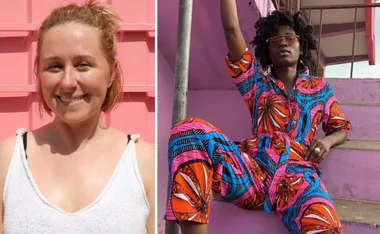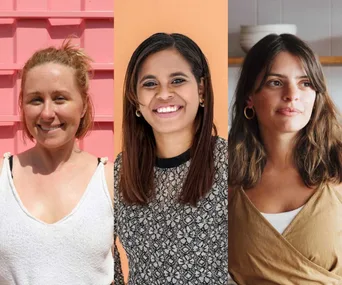The hospital delivery room was distressingly quiet.
No flurry of movement from medical staff, no joyful congratulations, no sound of a baby’s first tentative wails.
The silence is what Jacqui Bruyn remembers, with a sob, about the devastating stillbirth of her little boy, Beau.
It was 3.20am on April 25 four years ago, but for Jacqui and husband Trent Clark the trauma is still fresh, as if it happened only yesterday. They have learned to live with their overwhelming grief, but know it will never disappear nor fully heal.
“You know, when a baby is born, there’s usually a rush of activity and crying, and it just didn’t happen like that,” explains Jacqui, whose tiny son died in the womb 26 weeks into her pregnancy.

“It’s the most unnatural thing to give birth to death when you’re meant to be giving birth to life.” Jacqui on the stillbirth of her son, Beau.
(Supplied)“It was really confusing, I can’t even begin to explain it. They put Beau on my chest and I felt so much love. That instant connection was unbelievably strong, like nothing I had ever experienced in my life before.
“He was warm, like he was still alive, but after a while he started to go cold. It was horrific, just absolutely heartbreaking. I remember looking at my mum and saying, ‘he’s gone’. It’s the most unnatural thing to give birth to death when you’re meant to be giving birth to life.”
Jacqui and Trent’s longed-for first child had become a poignant statistic, one of the six babies lost to stillbirth every day in Australia, a mind-numbing figure that has not diminished for the past 20 years.
Incredibly, in this age of ground-breaking scientific discovery, the cause of most stillbirths remains a mystery, with stricken parents left to ask in vain why their precious babies never got a chance at life.
Finally, however, there is hope with the launch of a long-awaited National Stillbirth Action and Implementation Plan, a fivefold commitment to ensure high-quality prevention and care, raise awareness, improve bereavement support, prioritise research and enhance data collection.
Plus a new prevention and awareness campaign, Still Six Lives, which aims to slash the number of deaths by 20 per cent over the next five years through three simple risk-reduction strategies.
“It’s a policy movement to change stillbirth from being treated as a series of personal tragedies to a public health issue. This plan says enough is enough,” reflects Leigh Brezler, CEO of the Stillbirth Foundation.
“A 20 per cent reduction in the rate of stillbirths means more than 400 families each year will get to take their babies home instead of planning their funerals.”
The hidden toll of stillbirth – emotional, social and financial – is being brought out of the shadows. Today, parents are permitted to hold and grieve their lost children in hospital, sometimes for several days. Funerals are now staged for stillborn babies and their names are more often spoken than before.
With greater knowledge and empathy, fewer well-meaning friends and family are using the hurtful platitudes: ‘It obviously wasn’t meant to be … Don’t worry, you’ll get over it and have another baby.’
The conversation has started and understanding is growing.
“The grief is so heavy for those parents,” says Leigh, a dynamic mother of three. “Once you find out you’re pregnant, your mind flips to the first day of school, your child getting married sometime in the future and then suddenly, those dreams no longer exist …
“Stillbirth is the leading cause of neonatal death in Australia – more than 2000 per year – nearly double the national road toll.
“If you think how many road safety campaigns we run to try to prevent those deaths, the scale of this problem is simply not being recognised in the funds allocated to research. These are big numbers.
“There are cancers with much lower death rates that get much more money. Relative to the population and size of the issue, stillbirth is underfunded.
“But it’s just not out there in the collective consciousness because it’s a horrible, tragic thing that happens and most people don’t know how common it is.”
Sadly, Jacqui admits she was one of that ignorant majority, until baby Beau.
“Before that, I thought stillbirth was something that used to happen in medieval times,” she says, tenderly cradling her “rainbow” son Wyatt River, who entered the world 31 months after his ill-fated big brother.

Jacqui and Trent with their ‘rainbow’ son, Wyatt.
(Supplied)“The possibility was never mentioned to me at all. And no one ever told me about monitoring my baby’s movements. I feel so stupid in hindsight. I just had no understanding of what to look out for.”
Nonetheless, leaving work one Friday and realising her baby hadn’t kicked for a while, she felt the first twinges of anxiety.
On Saturday, going to meet a friend’s newborn, she pushed the worry away. But by Sunday night, she was sufficiently concerned to call her obstetrician, who told her to go to Sydney’s Mater Hospital straight away.
Jacqui and builder Trent, 40, clung to hope while fearing the worst. A couple since their early 20s, they had delayed starting a family to see the world and get ahead in their careers. At last they had believed the time was right.
“The midwife was trying to find a heartbeat, but she couldn’t,” recalls the 36-year-old lawyer and volunteer Stillbirth Foundation ambassador. “I could just feel something really wrong. It was like an out-of-body experience in a bad way, like watching somebody else’s horrible life unravel.
“After we found out the baby had died we wanted to see the image, because we just couldn’t believe it. Looking at the ultrasound it was so disturbing not to be able to see the heartbeat, while you could still see the baby.
“For a second, reliving the nightmare at her home in Sydney’s Gladesville, Jacqui is overcome. “That was also when we found out we had a son – we hadn’t discovered his gender until then – which was overwhelming.”

“I could just feel something really wrong. It was like an out-of-body experience in a bad way, like watching somebody else’s horrible life unravel.”
(Supplied)Even more confronting was the realisation that she would have to give birth vaginally to her dead child. Medical staff are usually reluctant to deliver babies like Beau by caesarean, because the risk of scarring to the uterus could jeopardise future pregnancies.
For the desolate mother-to-be, who cried for six hours, it was “another layer of horror”.
So early in her pregnancy, Jacqui hadn’t been to any birthing classes and had no idea what to expect, how much pain she might experience, what her little boy would look like when he finally arrived 15 hours after labour was induced.
“It’s brutal,” says Laura Sheehan, 35, whose second son – coincidentally also named Beau – was stillborn at 28 weeks on June 19, 2014.
“You’re acutely aware, while waiting to give birth, that there’s a deceased baby within you. Your body still thinks it is pregnant and holds on as long as it can, but in a way, the birth was extremely cathartic, because I got to scream through the pain and almost connected with him a little longer.”
Just one week beforehand, she and toddler Brody had been reunited with husband Brett in the south of France, where he had “one final contract” to play out his professional rugby career.
It was an exciting time for the little family, exploring historic Narbonne together, shopping at the local IKEA, visiting the nearby beach.

“I got to scream through the pain and almost connected with him a little longer.” Laura Sheehan talking about her own stillbirth.
(Supplied)Over the course of the weekend, Laura became increasingly concerned about her unborn child. Always very placid, quite different from her first pregnancy with Brody, he seemed to have stopped moving altogether.
With a feeling of dread and a quiet certainty that her baby was already dead, she went to the local hospital for an ultrasound. Brett beamed with pride as he saw the outline of his big, strong baby boy for the first time, but Laura was focused on just one thing – the unmistakable absence of any heartbeat.
“Non le coeur,” the doctor told them sorrowfully, as Laura screamed and a disbelieving Brett fell shattered to his knees.
“Everything slowed down –sounds, everything. I guess it was trauma,” says Laura, who lives on Sydney’s Northern Beaches with her 41-year-old husband, son Brody, now eight, and daughters Daisy, six, and Billy, three.
The kindness of midwives and medical staff transcended any language barrier, yet waiting for several days to give birth to Beau, the bereft mother felt her body had become a coffin.
Once full of hopeful life, now it carried helpless death.
“Mentally, I don’t think you ever recover from that sort of loss,” says Laura, a former teacher who works in communications.

Laura with her husband and three children.
(Supplied)“For me, the pain was very much driven into the need to become pregnant again, to start trying for another baby almost immediately. Having met other women who have experienced stillbirth, it’s either one way or the other.
“But the grief really caught up with me when Daisy was born, and it’s ongoing. Some years Beau’s birthday is a happy time, other years it’s hard to get out of bed.”
For Laura and Brett, just like Trent and Jacqui – who needed fertility treatment to conceive again – there was never an answer to the anguished question: why did my baby die?
And with no certainty, there is always tremendous, almost overwhelming fear of the same thing happening again in subsequent pregnancies.
“There’s a real sense of frustration. How do we not know what is causing all these deaths?” asks Dr Ashleigh Smith, 31, whose tiny daughter Isla passed away two days after she was born in very poor condition at Brisbane Mater Mothers’ Hospital on January 29 last year.
Neither her general medical experience, nor specialist obstetrics training, prepared Ashleigh for the anguish that overwhelmed her.
“In some ways I had an advantage because I’ve seen behind the veil –what happens when a baby dies. But then the absolute grief and sadness of having her pass away in my arms.

Dr Ashleigh Smith holding her daughter, Isla.
(Supplied)“I don’t think the human soul is made to withstand that. It’s very destructive … I’d seen it in patients before and now it had happened to me,” says Ashleigh who, unable to find the bereavement support she needed, founded the Glimmer Project to help other women grieving stillbirth or neonatal loss, and was a finalist in The Weekly’s 2020 Women of the Future Awards.
“It had been a perfectly normal pregnancy. Isla’s death was a presumptive umbilical cord accident, which doesn’t make sense. I just don’t think that’s a good enough reason.
“Medically, if you don’t understand what’s happened in one pregnancy, you don’t know whether it will or won’t happen again in subsequent pregnancies. Medical staff can’t reassure you in those circumstances. Even though everything looks fine today, you can’t say what might happen tomorrow …
“There hasn’t been enough research, time or money put into pregnancy loss, and there should have been. That’s where we need to direct our energy and funding, because I really believe a lot of these deaths are preventable.”
Some stillbirths probably will remain a mystery forever.
But the risk can be reduced with three simple precautions, outlined in the Still Six Lives campaign: sleep on your side after 28 weeks of pregnancy; if you smoke, stop, and avoid being around other people’s smoke; be aware of your baby’s movements and contact your maternity care specialist immediately if they change.
“Every pregnancy is unique and every baby’s movements are unique,” explains Leigh.
“When it comes to stillbirth, we know there are things that can reduce the risk, and these should be acted upon. If you take these steps, it doesn’t mean your child will definitely be saved – the number of stillbirths will never be zero – but these are three very simple ways to advocate for your baby.
“Since NHS England introduced the Saving Babies’ Lives Care Bundle, recommending these behavioural changes, stillbirths have fallen by 20 per cent, and Scotland and the Netherlands have recorded similar success. It will work here, too.
“With better bereavement care and community support, we can lift the taboo of this silent tragedy,” adds Leigh, who is now pushing for paid stillbirth leave.
“Fewer parents will bear the heavy burden of grief or PTSD after the loss of their child. Fewer parents will hear phrases that start with ‘at least’. Fewer parents will have their former friends and acquaintances cross the road to avoid contact altogether.”
People just don’t know what to say, according to Laura.
“Only now are we really starting to be given permission to talk about our babies. It’s a community that no-one wants to be a part of … When we first lost Beau, it was quite a difficult discussion to have with people, but it’s so good to normalise the conversation.
“Stillbirth is a terribly isolating, lonely experience and we need, not just support, but also awareness. There are six stillbirths a day, yet until the Still Six Lives campaign, you weren’t told during pregnancy to monitor your baby’s movement.
“There needs to be more information, not to scare women but to make them aware, because awareness is knowledge and knowledge is power.”
Jacqui will always mourn her first baby, but gains solace raising funds for the Stillbirth Foundation with family and friends at the Blackmores Sydney Running Festival, which has unfortunately been cancelled this year due to COVID.
Team Baby Beau is always dressed in bright colours, sporting angel wings and glitter.
“We can feel the love and it makes me realise Beau has had such an impact on a lot of people,” she smiles, cuddling bonny, blue-eyed Wyatt. “It’s like his legacy, helping other little babies.
0“But things haven’t changed in the past 20 years, and that’s just not good enough. If something was happening to two-year-olds at this rate, there would be outrage.
“We have to change the mindset around these babies. They are important people who need to have a voice. We need to be the voice for them.”
To learn more, access support or make a donation, visit stillbirthfoundation.org.au, theglimmerproject.com and preventstillbirth.org.au. For information on the Blackmores Sydney Running Festival, visit sydneyrunningfestival.com.au
Read this story and more in the October issue of The Australian Women’s Weekly – on sale now.





